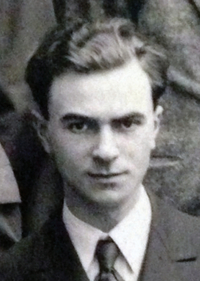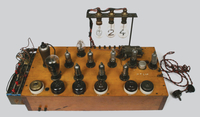Eryl Wynn-Williams invents the scale-of-two counter
|
1938 In 1930 whilst working at the Cavendish Laboratory in Cambridge Endland, Eryl Wynn-Williams devised a way to use electronic valves as counting devices. He connected several thyratrons in a ring circuit in which only one thyratron at a time could pass a current. Successive electric pulses would activate the thyratrons in sequence. A ring of five thyratrons connected to a mechanical counter could therefore handle five times the pulse rate of the counter itself. His ring counter was a great success, but he realised that the circuit could be considerably simplified if the ring were reduced to just a pair of thyratrons, which also much improved their performance and stability. He then optimised the use of valves for counting by connecting such pairs of thyratrons in series so that each pair counted only every second pulse received by the preceding pair. He termed this invention which is at the heart of all modern computing the “scale-of-two” counter. His innovations therefore marked the dawn not only of the use of electronics for counting purposes, but also the use of the binary numbers for electronic computation. Thyratrons, which first became commercially available in 1928, are triode valves which contain a low pressure gas such as argon or mercury vapour. If a positive pulse is applied to the grid of a thyratron, a self-sustaining anode current is set up that can only be stopped by dropping the voltage of the anode. The device therefore behaves like a two-state system rather than a linear amplifier. Several three‐bit counters were built for the laboratory. They were quickly put to use by the Cavendish’s physicists, including Chadwick who used one in his experiments that led to the discovery of the neutron in 1932. R. V. Jones, UK Government Scientific Intelligence advisor in the Second World War, wrote in Nature in 1981: ‘... the modern computer is only possible because of an invention made by a physicist, C.E.Wynn-Williams, in 1932 for counting nuclear particles: the scale-of-two counter, which may prove to be one of the most influential of all inventions.’ Author: Gareth Wynn-Williams Related information:
Images:
|
Click on the Images For Detail
|












